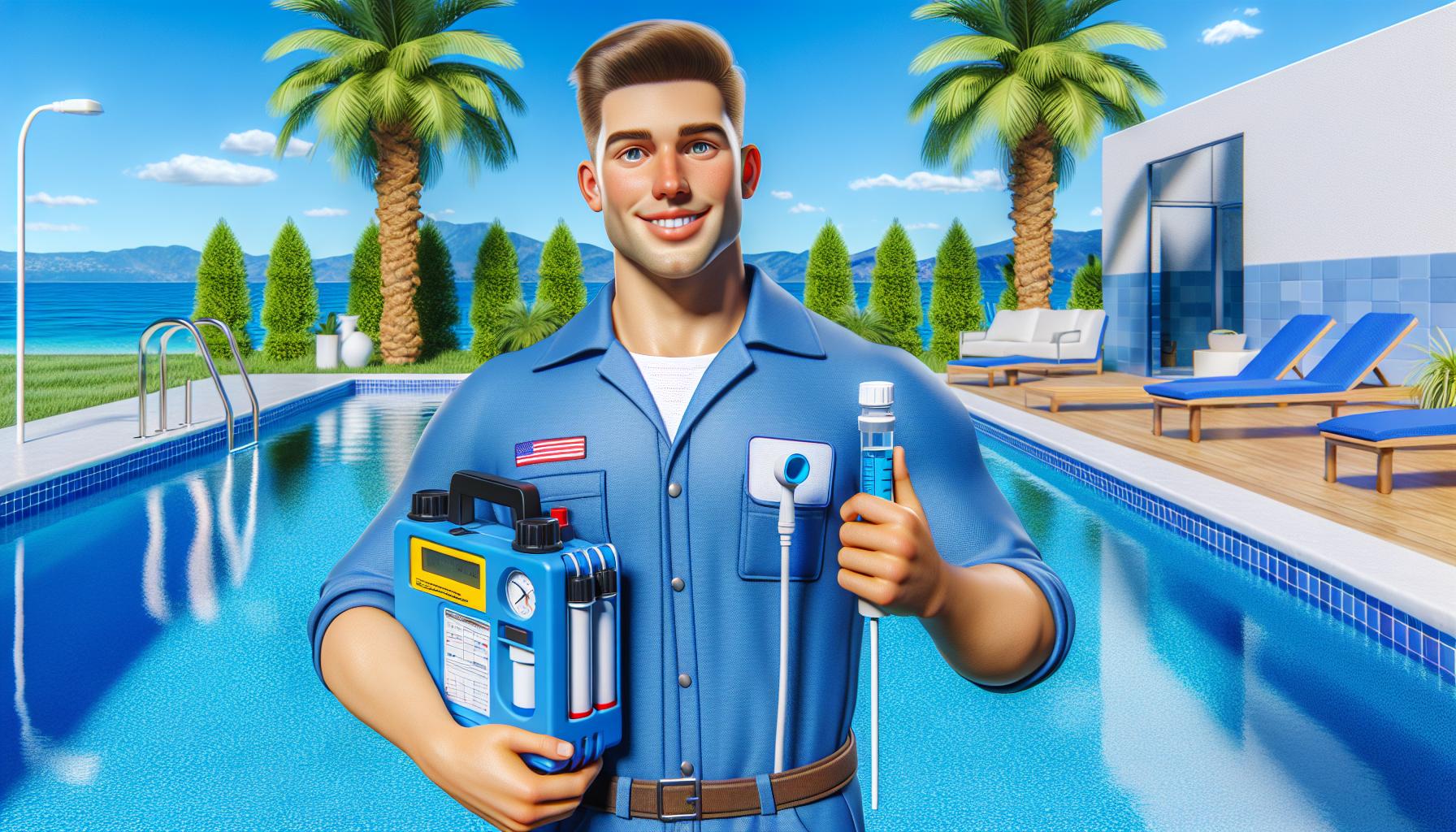Key Takeaways
- Understanding the chemistry of pool water is essential for safety, compliance, and cost-effective maintenance.
- Key chemical factors include pH levels (ideally between 7.2-7.8), chlorine balance (1-3 ppm), and total alkalinity (80-150 ppm) to ensure healthy swimming conditions.
- Regular testing and monitoring of water chemistry help prevent health risks and costly repairs, avoiding common mistakes like neglecting sanitizer levels.
- Effective pool management techniques, including the use of automated systems, can simplify monitoring and adjusting chemical levels for ease of maintenance.
- Knowledge of sanitizer types, such as chlorine and bromine, is crucial for keeping pool water free from harmful bacteria and ensuring a pleasant swimming experience.
When it comes to pool care, understanding the chemistry behind water quality is crucial. Did you know that nearly 50% of pool owners struggle with maintaining proper chemical balance? This can lead to unsafe swimming conditions and costly repairs. By diving deeper into chemical knowledge, we can ensure our pools remain safe and enjoyable for everyone.
In-depth chemical knowledge not only helps us maintain crystal-clear water but also keeps us compliant with health regulations. With the right understanding, we can tackle issues like pH levels, chlorine balance, and total alkalinity effectively. Let's explore why mastering these concepts is essential for every pool owner looking to create a safe and inviting aquatic environment.
Importance of Water Quality in Pool Care
Water quality plays a vital role in maintaining a safe and enjoyable swimming experience. Understanding the chemical balance helps us avoid health risks and costly repairs. Knowledge of chemical factors like pH levels and chlorine balance can transform our pools into healthy recreation areas.
The Role of Chemical Composition
Chemical composition directly influences pool water quality. Factors such as pH, chlorine, and total alkalinity create a balanced environment. When pH levels remain between 7.2 and 7.8, swimmers enjoy optimal comfort and safety. Keeping the right chlorine levels, typically between 1 and 3 parts per million, prevents harmful bacteria growth. We can think of chemical composition as the secret recipe for a perfect pool cocktail—get the mix right, and we’re swimming in paradise!
Key Chemicals in Pool Maintenance

Understanding key chemicals in pool maintenance helps us create a safe and enjoyable swimming environment. Proper chemical balance simplifies our pool care routine and enhances swimmer comfort.
Sanitizers and Disinfectants
Sanitizers like chlorine, bromine, and biguanide act like lifeguards for our pool water, tackling harmful bacteria, viruses, and algae. Here are the ideal levels for these vital chemicals:
- Chlorine: 1-3 ppm
- Bromine: 3-5 ppm
- Biguanide: 30-50 ppm
- Mineral systems: 0.5 ppm of chlorine
These sanitizing agents keep our pool water clean and safeguard us from potential illnesses. We all want a pool that encourages joyful splashes, not what-ifs about safety.
pH Balancing Agents
Maintaining the right pH balance in our pools helps optimize sanitizer effectiveness while ensuring a pleasant swimming experience. The ideal pH range sits between 7.2 and 7.8. When pH levels fall outside this range, we might experience discomfort like itchy skin or red eyes. Regular testing helps us steer clear of these issues—seriously, who wants to look like they just emerged from a pool party in a horror movie?
Chemical Knowledge and Safety Compliance

In-depth chemical knowledge is vital for maintaining water quality and safety in pool care. Understanding chemical interactions helps us avoid health risks and costly repairs, making our pools enjoyable and compliant with regulations.
Understanding Chemical Interactions
Chemical interactions play a crucial role in pool maintenance. Monitoring pH levels, alkalinity, and sanitizer concentrations ensures our pools stay clean and safe. For instance, the ideal pH range is between 7.4 and 7.6. Outside this range, equipment can corrode and swimmers may experience discomfort. We also need to keep our total alkalinity between 80 and 150 ppm and maintain calcium hardness from 200 to 400 ppm. Knowing these parameters enhances our knowledge, allowing us to manage our pools effectively.
Regular testing is also key. Available services help us with chlorine balance and effectiveness. Automated systems can simplify monitoring and mitigate risks like algae growth. What systems do we currently use?
Avoiding Common Pool Care Mistakes
Pool care comes with its fair share of pitfalls. We tend to overlook key maintenance tasks, which can lead to safety issues. One common mistake is ignoring sanitizer levels. If chlorine levels drop below 1 ppm, bacteria can thrive while we swim blissfully unaware. Another blunder is neglecting to balance total alkalinity, which affects pH stability. High alkalinity leads to cloudy water, while low levels can cause skin irritation.
Techniques for Effective Pool Management

We understand that maintaining a swimming pool's water quality requires consistent methods that keep swimmers safe and compliant. Here are key techniques for effective pool management.
Regular Testing and Monitoring
Regular testing and monitoring of water chemistry serve as the foundation for safe pool enjoyment. We should test pH levels, total alkalinity, and sanitizer levels at least once a week. Testing strips or reliable water testing kits can simplify this process. If the pH drifts outside the ideal range of 7.2 to 7.8, swimmers might experience irritation.
Monitoring also includes checking chlorine levels. A range of 1 to 3 parts per million prevents bacteria growth. Automated systems can streamline this process, sending smartphone alerts when chemical levels need attention, thus making pool maintenance less of a chore. These tools, like a mobile field service app, help us stay on top of pool care, enhancing our experience.
Adjusting Chemical Levels
Adjusting chemical levels involves adding the right amount of balancing agents. If pH levels are too low, adding soda ash can raise the pH. Conversely, adding muriatic acid lowers high pH levels. When total alkalinity is low, we can add baking soda to stabilize the pH.
For those moments when we forget to monitor closely, an automated solution provides real-time feedback. It’s like having a technician in our pocket, prompting us to tweak settings as needed. Besides making pool management convenient, these options free us up for more leisure time.
Conclusion
Mastering pool chemistry is essential for us as pool owners. By understanding the chemical balance in our pools we not only ensure safety but also enhance the overall swimming experience. Regular testing and monitoring allow us to catch potential issues early and maintain compliance with health regulations.
Utilizing automated systems simplifies our management tasks and keeps our pools enjoyable for everyone. With the right knowledge and tools we can create a clean and inviting environment that maximizes our leisure time while minimizing risks. Let’s commit to being proactive in our pool care so we can enjoy every splash with peace of mind.
Frequently Asked Questions
What is the ideal pH level for pool water?
The ideal pH level for pool water should be maintained between 7.2 and 7.8. This range ensures optimal swimmer comfort and the effectiveness of sanitizers, preventing issues like itchy skin and red eyes.
How often should I test my pool water?
It’s recommended to test your pool water at least once a week. Regular testing helps maintain proper chemical balance, ensuring a safe and enjoyable swimming experience.
What are the ideal chlorine levels for pools?
The ideal chlorine levels for pool water should be between 1 and 3 parts per million (ppm). This range effectively kills harmful bacteria while providing a safe swimming environment.
What chemicals are essential for pool maintenance?
Essential chemicals for pool maintenance include sanitizers like chlorine (1-3 ppm), bromine (3-5 ppm), and biguanide (30-50 ppm). These keep the water clean and safe from harmful microorganisms.
How can I adjust pH levels in my pool?
To raise low pH levels, you can use soda ash, whereas muriatic acid is effective for lowering high pH levels. Always follow product instructions for safe and accurate adjustments.
What is the importance of total alkalinity in pool care?
Maintaining total alkalinity between 80-150 ppm is essential for pool care. It stabilizes pH levels, improves sanitizer effectiveness, and prevents swimmer discomfort.
Can automated systems help with pool maintenance?
Yes, automated systems can simplify pool maintenance by providing real-time alerts for chemical adjustments. They ensure consistent monitoring and help prevent common pool care mistakes.
Why is understanding chemical interactions important in pool maintenance?
Understanding chemical interactions is crucial to prevent issues like algae growth and equipment corrosion. Regular monitoring helps maintain a safe swimming environment and prolongs the lifespan of pool equipment.






